GIANT SWALLOWTAIL Papilio
cresphontes
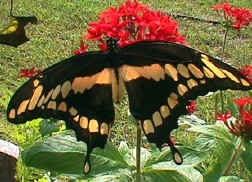 The Giant Swallowtail is one of the largest butterflies
in the United States (along with the Tiger Swallowtails).
Giants can be easily identified, even in flight. Their large size is an obvious give
away - about 6 inches from wing to wing. The top side of the wings are dark brown
(almost black) with prominent yellow bands. As if that wasn't
The Giant Swallowtail is one of the largest butterflies
in the United States (along with the Tiger Swallowtails).
Giants can be easily identified, even in flight. Their large size is an obvious give
away - about 6 inches from wing to wing. The top side of the wings are dark brown
(almost black) with prominent yellow bands. As if that wasn't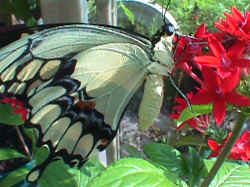 enough, they are yellow on the underside, which contrasts with the black
topside. The broken pattern on the yellow underside of its wings helps conceal it
from predators. From above, the Giant Swallowtail looks like dappled sunlight
hitting a dark leaf. The hindwing has a red and black eyespot and a tail that is
yellow near the tip. On the underside of the hindwing, there is a blue band and a
enough, they are yellow on the underside, which contrasts with the black
topside. The broken pattern on the yellow underside of its wings helps conceal it
from predators. From above, the Giant Swallowtail looks like dappled sunlight
hitting a dark leaf. The hindwing has a red and black eyespot and a tail that is
yellow near the tip. On the underside of the hindwing, there is a blue band and a 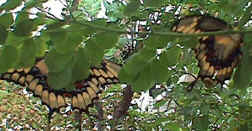 small orange patch near the center.The sexes are similar, but the females
are paler yellow and have a narrower yellow band at the base of the topside hindwing
small orange patch near the center.The sexes are similar, but the females
are paler yellow and have a narrower yellow band at the base of the topside hindwing
Giant Swallowtails prefer open woodlands and fields,
citrus groves, and gardens near woodlands. Their range is north to Virginia and
Iowa, west to southern Arizona, south to the West Indies and northern South America.
Normally a strong, high flier, the Giant Swallowtail is easily be enticed down to
flowers, drink from them long and thirstily. They are especially fond of Butterfly
Bush (Buddleia davidii) and Lantana (Lantana spp.). It also drinks from mud, fruit
juices, and manure.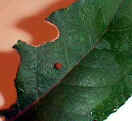
 Eggs are
large, round, and orange in color. Females lay eggs one or two at a time on the new
growth. Young caterpillars eat only young, tender leaves and rest exposed on the
upper leaf surfaces. Older caterpillars more often rest on twigs and branches.
Eggs are
large, round, and orange in color. Females lay eggs one or two at a time on the new
growth. Young caterpillars eat only young, tender leaves and rest exposed on the
upper leaf surfaces. Older caterpillars more often rest on twigs and branches.
The first three caterpillar stages are black and
white and resemble bird droppings. The 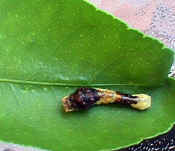 last two stages are brown with whitish patches on the
tail end, around the middle and the sides of the front part of the body. Like other
Swallowtails, these caterpillars have a bright red-orange forked organ (called an
osmeterium) which emits a noxious odor. They stick out these scent horns to repel
ants or other predators that might try to attack them.
last two stages are brown with whitish patches on the
tail end, around the middle and the sides of the front part of the body. Like other
Swallowtails, these caterpillars have a bright red-orange forked organ (called an
osmeterium) which emits a noxious odor. They stick out these scent horns to repel
ants or other predators that might try to attack them.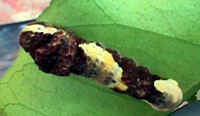
The Giant Swallowtail caterpillars feed on
leaves in the Rutaceae (citrus) family. They are called 'orange dogs' in south
Florida, because of their love for Orange tree leaves. They're considered a minor
agricultural pest down there. They will eat (in addition to cultivated citrus) many
native citrus leaves: Wafer Ash or Hop Tree (Ptelea trifoliata), Torchwood
(Amyris elemifera), wild lime or Prickly Ash (Zanthoxylum fagara), and
Hercules-club 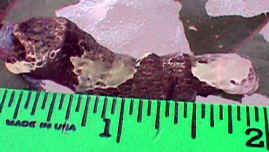 (Zanthoxylum
clava-herculis). I've raised them on Key Lime (citrus aurantifolia)
leaves as well as Hercules Clubs. Also, they will consider Sweet orange (Citrus
sinesis), Sour Orange (Citrus aurantium), Tangerine (Citrus reticulata),
Grapefruit (Citrus mazima), and lemon (Citrus limon), Box Thorn (Severinia
buxifolia), Rue (Ruta graveolens), and Trifoliate
Orange (Poncirus trifoliata) which is used as a rootstock on which citrus is
grafted. Females will lay on Nagami Kumquat (Fortunella margarita), but the
larvae do not seem able to survive on this plant. Zanthoxylum spp. and Wafer Ash
seem to be the preferred host plants.
(Zanthoxylum
clava-herculis). I've raised them on Key Lime (citrus aurantifolia)
leaves as well as Hercules Clubs. Also, they will consider Sweet orange (Citrus
sinesis), Sour Orange (Citrus aurantium), Tangerine (Citrus reticulata),
Grapefruit (Citrus mazima), and lemon (Citrus limon), Box Thorn (Severinia
buxifolia), Rue (Ruta graveolens), and Trifoliate
Orange (Poncirus trifoliata) which is used as a rootstock on which citrus is
grafted. Females will lay on Nagami Kumquat (Fortunella margarita), but the
larvae do not seem able to survive on this plant. Zanthoxylum spp. and Wafer Ash
seem to be the preferred host plants.
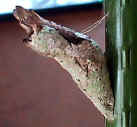 The chrysalis is brown with dark markings and patches
of green, resembling a piece of wood. The
The chrysalis is brown with dark markings and patches
of green, resembling a piece of wood. The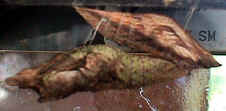 upper half is
suspended by a silk girdle. The bottom is attached to a little silk button on a
tree. The pupa (chrysalis) is the overwintering stage. BUT... they don't
always overwinter!
upper half is
suspended by a silk girdle. The bottom is attached to a little silk button on a
tree. The pupa (chrysalis) is the overwintering stage. BUT... they don't
always overwinter!
"Double
decker" chrysalis'.
A
Giant Swallowtail (bottom) pupating
right
on top of a Black Swallowtail (top)
Back to the butterflies 
MORE GIANT PHOTOS
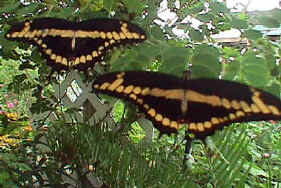 .
.
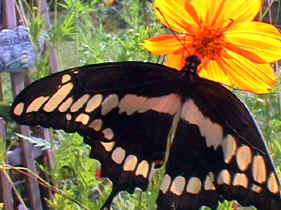
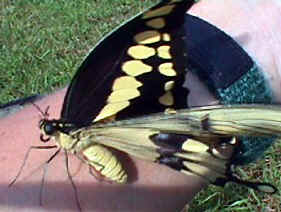
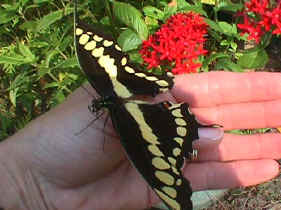
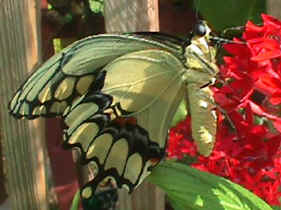
 The Giant Swallowtail is one of the largest butterflies
in the United States (along with the Tiger Swallowtails).
Giants can be easily identified, even in flight. Their large size is an obvious give
away - about 6 inches from wing to wing. The top side of the wings are dark brown
(almost black) with prominent yellow bands. As if that wasn't
The Giant Swallowtail is one of the largest butterflies
in the United States (along with the Tiger Swallowtails).
Giants can be easily identified, even in flight. Their large size is an obvious give
away - about 6 inches from wing to wing. The top side of the wings are dark brown
(almost black) with prominent yellow bands. As if that wasn't enough, they are yellow on the underside, which contrasts with the black
topside. The broken pattern on the yellow underside of its wings helps conceal it
from predators. From above, the Giant Swallowtail looks like dappled sunlight
hitting a dark leaf. The hindwing has a red and black eyespot and a tail that is
yellow near the tip. On the underside of the hindwing, there is a blue band and a
enough, they are yellow on the underside, which contrasts with the black
topside. The broken pattern on the yellow underside of its wings helps conceal it
from predators. From above, the Giant Swallowtail looks like dappled sunlight
hitting a dark leaf. The hindwing has a red and black eyespot and a tail that is
yellow near the tip. On the underside of the hindwing, there is a blue band and a  small orange patch near the center.The sexes are similar, but the females
are paler yellow and have a narrower yellow band at the base of the topside hindwing
small orange patch near the center.The sexes are similar, but the females
are paler yellow and have a narrower yellow band at the base of the topside hindwing
 Eggs are
large, round, and orange in color. Females lay eggs one or two at a time on the new
growth. Young caterpillars eat only young, tender leaves and rest exposed on the
upper leaf surfaces. Older caterpillars more often rest on twigs and branches.
Eggs are
large, round, and orange in color. Females lay eggs one or two at a time on the new
growth. Young caterpillars eat only young, tender leaves and rest exposed on the
upper leaf surfaces. Older caterpillars more often rest on twigs and branches. last two stages are brown with whitish patches on the
tail end, around the middle and the sides of the front part of the body. Like other
Swallowtails, these caterpillars have a bright red-orange forked organ (called an
osmeterium) which emits a noxious odor. They stick out these scent horns to repel
ants or other predators that might try to attack them.
last two stages are brown with whitish patches on the
tail end, around the middle and the sides of the front part of the body. Like other
Swallowtails, these caterpillars have a bright red-orange forked organ (called an
osmeterium) which emits a noxious odor. They stick out these scent horns to repel
ants or other predators that might try to attack them.
 (Zanthoxylum
clava-herculis). I've raised them on Key Lime (citrus aurantifolia)
leaves as well as Hercules Clubs. Also, they will consider Sweet orange (Citrus
sinesis), Sour Orange (Citrus aurantium), Tangerine (Citrus reticulata),
Grapefruit (Citrus mazima), and lemon (Citrus limon), Box Thorn (Severinia
buxifolia),
(Zanthoxylum
clava-herculis). I've raised them on Key Lime (citrus aurantifolia)
leaves as well as Hercules Clubs. Also, they will consider Sweet orange (Citrus
sinesis), Sour Orange (Citrus aurantium), Tangerine (Citrus reticulata),
Grapefruit (Citrus mazima), and lemon (Citrus limon), Box Thorn (Severinia
buxifolia),  The chrysalis is brown with dark markings and patches
of green, resembling a piece of wood. The
The chrysalis is brown with dark markings and patches
of green, resembling a piece of wood. The upper half is
suspended by a silk girdle. The bottom is attached to a little silk button on a
tree. The pupa (chrysalis) is the overwintering stage. BUT... they don't
always overwinter!
upper half is
suspended by a silk girdle. The bottom is attached to a little silk button on a
tree. The pupa (chrysalis) is the overwintering stage. BUT... they don't
always overwinter! .
.


